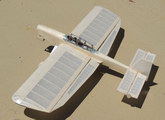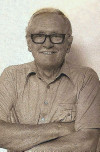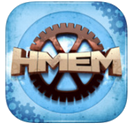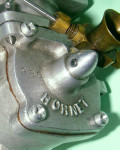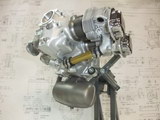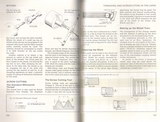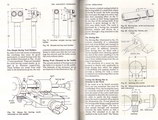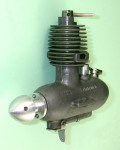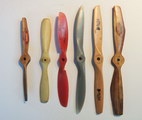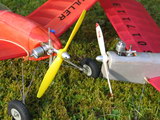Model Engine News: November 2013 (bis 4)
Special Features:
Regular Features:
 Editorial
Editorial
 New Books and Magazines This Month
New Books and Magazines This Month
 Engine Of The Month: Zeiss Pioneer
Engine Of The Month: Zeiss Pioneer
 Tech Tip of the Month
Tech Tip of the Month
 Briefly Noted
Briefly Noted
 Standard Stuff
Standard Stuff
|
Unless otherwise expressed, all original text, drawings, and photographs created by Ronald A Chernich appearing on the Model Engine News web site are licensed under a Creative Commons Attribution-Noncommercial-Share Alike 3.0 License. |

|
Editorial
This is, beyond doubt, the hardest Editorial I've ever had to write, being my "So long, and thanks for all the fish..." issue. In the past month, the cancer has quite got the better of me (see the June 2010 Editorial Extra) and I've spent a period in hospital having "palliative care". In other words, treatment has failed, so now we just try to manage the pain for as long as possible, or until it is simply unbearable, and that's all, she wrote. Bummer. However I'm pleased to say I feel no anguish, bitterness, nor any trace of self-pity, having always been a "that which cannot be changed must be endured" kind of guy.
Now, the consequences. Our regular, monthly doses of Model Engine News will cease with the December, 2013 issue. Even now, my rigid first of the month publishing schedule is shot to hell and I'll make no commitment to making the first for the December target either, but it will emerge. Second, the effort to produce and dispatch DVDs and CDs is too much for me, so you will notice:
- Membership is closed, and no more MEN Update discs can be made.
- The highly popular Motor Boy's Plan Book on CD is also discontinued.
- A handy "Donate" button has been added for those wishing to express their appreciation.
But DON'T PANIC! because...
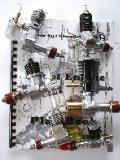
The Ultimate MEN issue scheduled for next month will make the Motor Boy's Plan Book available, freely, to everyone as a download. Now it's a bit big, being almost 10MB as a single PDF file, however experience over the last few years suggests that most modern systems and broadband plans will eventually deliver the goods using a simple html download, which is what should appear here next month. I think this is the right thing to do, and CD orders have been refunded immediately for the past two months, so nobody should feel that they've been tricked. Overall, I'm pleased and a tad excited about it and sincerely hope that it encourages others out there to give model IC engine making a go.
Now, as to the status of the November 2013 MEN issue, and the future of the web site. It's obviously two weeks late already and nowhere near done. My plan is to dribble out bits periodically, and by the time we reach December, we should have a November that's not too shabby. I'd like December to appear as a nice complete bundle, but that may be unrealistic, so we'll just have to see what happens. As to the site itself, I'll make provisions for it to continue for a year or so, and ensure that a full dump of the content and all the tools and scripts used to build it—including documentation on the process—is distributed to enough trusted people that it can be re-created elsewhere if necessary. If anyone wants to provide a permanent, cost and advertising free home for it, please let me know. Domain registration will be extended for as long as my provider will permit.
Emails continue to arrive from all over, in all cases being totally understanding about the late November issue, wishing me well, and lavishing praise on the MEN content and the help and enjoyment that it has provided. This is just wonderful to me—I could not ask for more, though <big grin> you may notice that I've replaced the "Buy Now" Membership link in the left-hand navigation bar with a "Donate" button; feel free to hammer on it...  .
.
Finally, I'm pleased to report that before the wheels fell off and Ruthie, who is now wearing a new diamond engagement ring, packed me up, kicking and screaming, and sent me off to the hospital for a tune-up, I managed to complete the Stuka airframe, including the wheel pants and my new, ingenious method for attaching same. It just needs some light weight glass cloth around the canopy rim and the hard wear area over the nose, finishing resin on the fuse, fillets, final engine plumbing, color scheme, ink lines, and air-brushing. Small jobs, right? I guess we already know that little jobs like those can just about equal the entire work to date. As they say in the amateur aircraft building world, you will spend more time in front of the firewall than you did behind it. Still, I'm determined to finish and fly this aeroplane, then it's maybe onto one of those intricate, detailed Hasagawa static kits for the SE5a, or Sopwith Camel which I've had stashed for ages, or maybe the big, beautiful scale model of Nelson's Victory, also stashed (two to choose from—who'se an utter nutter then?). I will be a modeler until the end, so there.
MEN goes Agile
In the software development world, "Agile Programming" became all the rage six or eight years back, or so. Simply put, Agile development targets small, fast cycles of a week or two, with each incrementally adding some working functionality to an agreed specification. The intent is to get something in front of the users fast, but of sufficient quality that the pin can be pulled at any time and still leave the project sponsor with *something* which works, to some extent. Well that's what is happening below, folks. My cycles will try to be no longer than a week, building to a respectable Nov issue before December is due. So keep checking back. The next cycle should deliver a super Adrian Duncan Company profile which I know you'll enjoy.
Company Profile: Aerol
Not many these days recall that before there was Elfin, there was Aerol. Both were the product of Frank Ellis (1909-2003). We've had a good profile of Frank in our People Index for some time. Our resident Motor Boy Historical Researcher, Adrian Duncan, has managed to collect all we know about Frank Ellis prior to the introduction of the "Elfin" range. These engines were the 2cc Aerol Gremlin, and the 2cc Aerol Hurricane. Why the fixation on the strange displacement of 2cc? All will be revealed, and the name Aerol has been added to the Companies Index, where the peculiarities of alphanumeric sorting places it at the top of the list. We hope enjoy the story, it's another brick in the wall of how early, post-WWII model engine builders came to be.
HMEM
Long time, careful readers of these pages over the past sixteen years will be forgiven for concluding I have something against Forums. It's true, I was once a junkie, but that was back in the bad old days of Bulletin Boards, 110 baud, and acoustic couplers, when "hacker" was a term of respect, and I were one! I even extended into the dial-up modem era, but the minute I saw Tim Berners-Lea's World Wide Web concept, I knew the bulletin board was dead. For reasons various, partly my decision to kick the habit, I did not migrate to Forums.
Sure, I'm a member of some for technical and product Forums, purely for professional reasons. For the most part, I've found them useful for finding out things I needed to know quickly in my work. I especially respect the Perl Monks as a gathering of amazing Perl knowledge, experience, and friendly, helpful people, but for the most part, I've totally avoided model engineering and engine making forums, merely noting their existence, although not that exhaustively, through our Links Page with a special section for Forums.
Well the drought has been broken by a kind reader who forwarded me the link to a HMEM Forum topic where someone was after the MEN ED Baby plan. As Membership had just closed, he was in trouble, but ignoring his plight for the moment, here was a Forum saying nice things about me! Even better, they offer an iPad app (and an Android one) to make it easy for tablet users, which circumstances dictate is me from now on, mostly. How could I not join, and having done so, let y'all know about this forum dedicated to model engine building, their projects, problems, and triumphs. If you are into modern Forums, you might like to give it a look. I've even added it to our links page.
To ensure a happy ending, and to help the dude who was after the MEN Baby plan set, I opened the Membership gate a last time and he is now happily enjoying the benefits of on-line membership, with the added extra joy of the DVD Cookies yet to come in the mail.
 End of ASIDE.
End of ASIDE.
Hop-Ups
Hop-ups have been around since the reliability of our model IC engines reached the level where repeatable results were being delivered by engine manufacturers. Under the impetus of competition, engine owners began looking for that tiny edge, the performance enhancing modification, small or large, which would be too time consuming and hence too expensive for the engine maker to contemplate, but which could be carried out at home by a patient, skilled user. The main target of such mods in the early days were the racing 60's. To pick a few from the early days, engines like the McCoy 60, the Hornet, the Dooling 61, the British Nordec, the Bungay 60, etc. Adrian has penned a follow-on to his earlier piece which described the Hornet 60, the first purpose-built competition racing engine in which he examines they ways owners have looked for that something extra to move then a few seconds (or milliseconds in some cases) ahead of their rivals. You probably should review the Hornet page first, but we think the Tuned Hornets page does a fair job as a stand-alone page.
Nano Times Three
As I've said many times, making an engine of 0.5cc displacement or less is a demanding task and a running engine is a truly significant accomplishment. As size decreases, the demand of fits and precision in achieving precisely circular cylinder bores and pistons becomes super critical. Even inserting a tight gudgeon pin (wrist pin to those in the US) can distort the piston sufficiently that it looses circularity, and compression. So Richard Klopp has every times to feel proud as he has completed not one but THREE Richard Gordon designed 0.1cc Nano Diesels! Click the Ducks in a Row image, or follow this link to read more about Richard's Nanos in Gallery.
Drawn Deeply
Those who know their engines and have spent any time in an old Piper Cub, or the EAA, should instantly recognize this as an amazingly faithful reproduction of the Continental C85, in miniature. The engine is the work of Dave Pape (Alberta, Canada). Dave got his start in model engineering by reading the venerable Model Engineer, and kindly cites MEN as the number one web page he reads EVERY month (Dave, you are making me feel guilty for pulling the pin  ). Now apart from the machining of the cylinder and the head fins, the crankcase and head machining, the replica deep drawn and joined oil tank, the detail on the inlet pipe joints, and the adjustable scale engine stand, look at those shiny, deep drawn rocker covers, complete with the "Continental" logo! It makes me feel like taking up stamp collecting, as do the plans Dave has drawn which he uses as a backdrop for his photo.
). Now apart from the machining of the cylinder and the head fins, the crankcase and head machining, the replica deep drawn and joined oil tank, the detail on the inlet pipe joints, and the adjustable scale engine stand, look at those shiny, deep drawn rocker covers, complete with the "Continental" logo! It makes me feel like taking up stamp collecting, as do the plans Dave has drawn which he uses as a backdrop for his photo.
Dave elected to work in 1/4 scale for the project and decided that if he could not make the Rocker Cover drawing dies and successfully produce the four covers, complete with logo, the project would be a no-go. Hence, those covers and the associated tooling was the first component made. Well, as we can see here, he managed to surmount all the problems associated with the first task, so had to continue. Even better, Dave has taken the time to describe and document how he built the tooling and made those rocker covers. With luck, a following wind, head down and cowl flaps closed, plus a willing Open Office, we will present the saga here, next month (who said we should go out with a bang? Oh wait, it was me!)
New Books and Magazines This Month
New? Not exactly, in fact, this one came as a free gift with my lathe, way back when. The head honcho at the company I bought my Myford Super7 from said that the manual supplied with the Myford was an embarrassment, so he included a copy of this book with every lathe he sold. Nice guy. The book is Myford Series 7 Manual: ML7 - ML7-R - SUPER7, by Ian Bradley, TEE Publishing, Leicestershire, England, ISBN 0905100883. The book was first published in 1973, and revised in 1977. A second edition appeared in 1982, with reprints in 1986, 1987, 1990, and probably several more since then, indicating that this has been a nice little earner for Ian Bradley, and a popular book with Myford owners, or would-be owners.
My copy is a paperback, printed in black and white with 232 pages divided into 20 chapters, plus a decent Index. Early chapters cover the basic components of the lathe, focusing on the ML7 range and the features it has which others may, or may not have. We get a chapter on installation which fails to mention Myford's "Leveling Blocks", an odd omission, but perhaps explained by the book's age. From there we logically continue with tools, sharpening of same, general turning operations, milling—using Myford's two styles of vertical slide attachment naturally— gear cutting, taper turning, repetition work, etc, etc. Understandably, Bradley uses Myford attachments extensively, but he does take a chapter to describe the two-tool back toolpost designed by Duplex in the Model Engineer, thousands of years ago, even though, or perhaps because Myford has their own rather chunky rear tool post offering. The book concludes with a series of tables, some of which are quite useful, and a lathe lubrication guide which I found less so. In this respect, the actual Myford lathe manual is superior.
This is a good book for someone who has just bought a Myford, or is contemplating buying one and wants to understand the differences between the models and the Myford range in general. The buy itself is a bolder decision these days, Myford having surprisingly closed the doors in 2011. Still, Model Engineers have been happily buying orphans for as long as there has been Model Engineers, which equates to over one hundred years. These days, I find the book to be of less use as a reference. If I want to do a thorough lubrication, I use Myford's manual. If I want a part number, or the assembly sequence for the headstock (yes, I've removed the leadscrew a couple of times over the years), again I go to Mr Myford's manual. But the Myford manual is not going to tell me how to cut a thread, or perform headstock division. Mr Bradley will. When it was all new to me, Ian Bradley's Myford book was my constant companion and I think I can say, it has been read, cover to cover. It was not until I'd done this, that I could appreciate the concise usefulness of the actual Myford manual.
So, an oldie, but a potential goodie, depending on your knowledge and experience level. I recommend it to new Myford owners with no more reservations than you can read between the above lines. You can buy copies from TEE Publishing in England, Amazon Booksellers, and ABE Books. I rank it as a four star effort  .
.
-oOo-
While we are at it, and to complete the set as it were, we'd best take a look at Ian Bradley's Amateur's Workshop, Nexus Special Interest, Argus books, Hemel, England, ISBN 1854861301. For another long, boring, and generally useless publishing history, the book first appeared in 1950. A New Edition appeared in 1971, which was reprinted in 1976, and 1979. The first paperback edition came out in 1984 and that was reprinted in 1986, 1987, 1988, and 1995! So this is one long-lived little book which has attracted sufficient demand to support that amazing and incomplete print history. I bought my copy on the strength of our earlier Bradley book and remember being a little disappointed.
The paperback edition contains 256 pages and a roughly 6" x 8" format. This tme we get 31 chapters, each dedicated to a tool, or process. For example, Chapter 31: Reamers, or Chapter 14: Toolmakers Buttons, and who could forget Chapter 4: Belt Drives. That one sort of dates it, doesn't it? Again we get the Two Tool Back Toolpost (unattributed this time, but the Duplex unit nevertheless). We also get full plans for a headstock dividing attachment—generic, no Myford specific devices this time—numerous boring bar designs, knurling devices, and a wobbler almost identical the GHT device which is the most useful and used tool I've ever made.
This leads us to the question, is this book too dated to be of use in the modern world? Yes, a lot of the material is dated, but so is a lot of the equipment used by Model Engineers today, not to mention the Engineers themselves! Several of the devices Bradley describes in detail are things we'd simply go out and buy today. Remember this book dates back to 1950, an era when the population was smaller, as was the disposable income of your average Joe, so building a boring tool holder from some steel scrap was a very attractive idea back then. Today, we'd just pick up a set of Chinese ones for pocket change at some importer. But look again at the book pages I selected above, and the use (Fig 20) of a "sticky pin" to trace the path the boring bar is going to trace. That idea is as old as the hills and as useful as tomorrow. I've done this often and have a blob of blu-tack gummed under one of my tooling drawers for just such quick use.
So I'm again giving Mr Bradley (or his estate) a tick for this book, especially if you are just starting out to Tool-up your Model Engineers' workshop. I'd rank the book as a luxury item rather than a necessity (GHT's book mentioned earlier is the necessity), still a useful thing to have a browse through for ideas on a day when it's too hot, or too cold to tackle anything in the (new) workshop. Available through Amazon Booksellers, and ABE Books, four stars  .
.
Engine Of The Month: Zeiss Pioneer
Arougah, Arougah! Dive, Dive, Dive! Adrian has sub-titled this one the "U-Boat" engine and if you look at the image the wrong way, it does sort of look like it should be cruising through the cold Atlantic waters, hidden in the darkness by the grey color, with conning tower, a cannon or something on the aft deck, and ballast underneath (extra points and a Zimmer Frame if you recall the B&W TV show our opening words came from...  ). The real name for the engine is the Pioneer, an apt title as this was the first model engine built by the respected Carl Zeiss optical company. Interested? The Zeiss engines all have a certain distinct look and appeal to me, especially the 1cc Jenna which became a special favourite of mine after I re-anodized the cylinder head for Bert Striegler's example of the Jenna. Anyway, be assured, after reading Adrian's Zeiss Pioneer Review, you will be an authority on the company and the engine. Happy reading for our penultimate EOM! (always thought I'd get to use that word, someday...)
). The real name for the engine is the Pioneer, an apt title as this was the first model engine built by the respected Carl Zeiss optical company. Interested? The Zeiss engines all have a certain distinct look and appeal to me, especially the 1cc Jenna which became a special favourite of mine after I re-anodized the cylinder head for Bert Striegler's example of the Jenna. Anyway, be assured, after reading Adrian's Zeiss Pioneer Review, you will be an authority on the company and the engine. Happy reading for our penultimate EOM! (always thought I'd get to use that word, someday...)
Tech Tip of the Month
As Ron has been a tad indisposed this month, we are pleased to have fellow Motor Boy and Musician, Adrian Duncan, take up the reins and give us a tech tip on Prop Selection for Classic Control-Line Models. I've drawn the distinction of "Musician" for Adrian, not just because he is one, who I had a lot of fun jamming with and just plain listening to earlier this year, but because his musical ear is rather germane to his selected topic. It's an unusual approach and we hope it gives you something to think about, and perhaps use! The How To Index has been updated accordingly.
Gnats' Knees
Now, just before we sign out for the penultimate time, lookie here! Aren't they cute? Two shop-made mini-diesels with free-flight airframes—both low-wingers, no less!—built by Mark Lester (UK). On the left we have Dart replica in a Schiffermuller, while on the right is a Clan replica in Mark's Fortune. Both models successfully sortie'd at the September 2013 Middle Wallop field get-together. Lot of fun had by all, especially Mark who must have used almost half an ounce of fuel for his day's flying. Just goes to show, our readers are not building show-ponies; these little guys ca really perform and I like to pretend that this web site has had some kind of hand in achieving this happy state of being.
Briefly Noted
This section is intended to alert you to little things that are hard to expand to a full news item, or cunningly wind into the Editorial, but are worthy of note never the less.
- One of the good things about this site is its size. Unfortunately, that's also a bad thing because unless I've been very careful, good stuff becomes lost! This was nearly the case with some first-hand information provided by the son of Mr Arthur Lewis Hardinge. This was written ages ago, but not indexed of any "main" index, so the fact that we know a lot about the designer of the Mills 1.3 was essentially lost! All fixed now and you'll find him in the People Index as both Pioneer, and a company!
- Owen Engines Australia has a new price list available. Yes, David Owen is a good friend, but I have no commercial connection to his business (I wish!). He just seems to sell good stuff at reasonable prices and I'm pleased to let others know about it.

